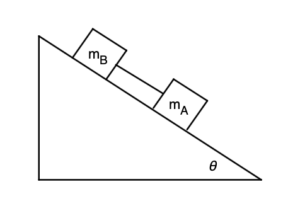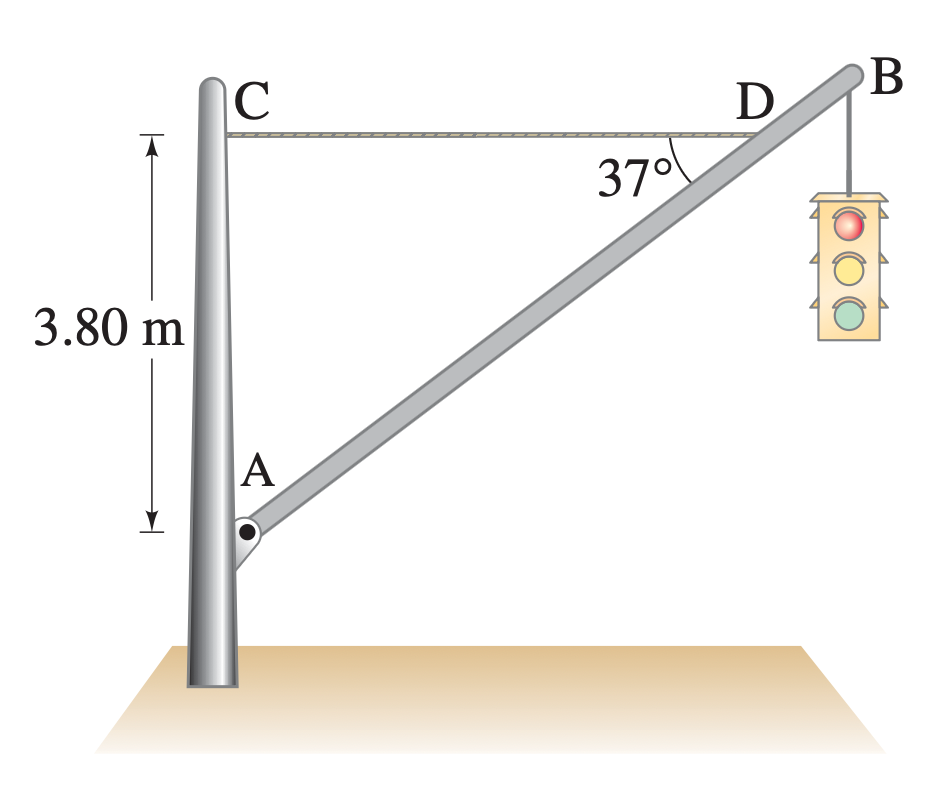0 attempts
0% avg
UBQ Credits
Part A – Angular Speed
| Step | Derivation/Formula | Reasoning |
|---|---|---|
| 1 | \[T\cos(\theta)=mg\] | The vertical component of the tension \(T\) balances the gravitational force \(mg\) on the ball. |
| 2 | \[T\sin(\theta)=m\omega^2r\] | The horizontal component of \(T\) provides the centripetal force (\(m\omega^2r\)) needed for circular motion. |
| 3 | \[\frac{T\sin(\theta)}{T\cos(\theta)}=\frac{m\omega^2r}{mg}\] | Dividing the horizontal equation by the vertical one eliminates \(T\) to relate \(\omega\) and \(\theta\). |
| 4 | \[\tan(\theta)=\frac{\omega^2r}{g}\] | This simplifies the relationship between the angle \(\theta\) and the angular speed \(\omega\). |
| 5 | \[\omega^2=\frac{g\tan(\theta)}{r}\] | Solving for \(\omega^2\) in terms of \(\tan(\theta)\), \(r\), and \(g\). |
| 6 | \[\sin(\theta)=\frac{r}{\ell}\quad \text{and}\quad \cos(\theta)=\sqrt{1-\frac{r^2}{\ell^2}}=\frac{\sqrt{\ell^2-r^2}}{\ell}\] | Using the geometry of the conical pendulum, where the horizontal radius \(r\) relates to the string length \(\ell\) and angle \(\theta\). |
| 7 | \[\tan(\theta)=\frac{\sin(\theta)}{\cos(\theta)}=\frac{r}{\sqrt{\ell^2-r^2}}\] | Expressing \(\tan(\theta)\) in terms of the given variables \(r\) and \(\ell\). |
| 8 | \[\omega^2=\frac{g}{r}\cdot\frac{r}{\sqrt{\ell^2-r^2}}=\frac{g}{\sqrt{\ell^2-r^2}}\] | Substituting the expression for \(\tan(\theta)\) into the equation for \(\omega^2\) simplifies the result. |
| 9 | \[\boxed{\omega=\sqrt{\frac{g}{\sqrt{\ell^2-r^2}}}}\] | Taking the square root yields the final expression for the angular speed \(\omega\) in terms of \(\ell\), \(r\), and \(g\). |
Part B – Tension
| Step | Derivation/Formula | Reasoning |
|---|---|---|
| 1 | \[T\cos(\theta)=mg\] | The vertical component of the tension balances the weight of the ball. |
| 2 | \[T=\frac{mg}{\cos(\theta)}\] | Solving for the tension \(T\) from the vertical equilibrium equation. |
| 3 | \[\cos(\theta)=\frac{\sqrt{\ell^2-r^2}}{\ell}\] | Expressing \(\cos(\theta)\) in terms of the string length \(\ell\) and the horizontal radius \(r\) using geometry. |
| 4 | \[T=\frac{mg}{\frac{\sqrt{\ell^2-r^2}}{\ell}}=\frac{mg\ell}{\sqrt{\ell^2-r^2}}\] | Substituting \(\cos(\theta)\) into the equation for \(T\) and simplifying. |
| 5 | \[\boxed{T=\frac{mg\ell}{\sqrt{\ell^2-r^2}}}\] | This is the final expression for the tension \(T\) in the string in terms of \(L\) (\(\ell\)), \(m\), \(r\), and \(g\). |
Just ask: "Help me solve this problem."
What is the mass of a dog that weighs \(58 \, \text{N}\) on Earth?
 Two blocks made of different materials, connected by a thin cord, slide down a plane ramp inclined at an angle \( \theta = 32^\circ \) above the horizontal. If the coefficients of friction are \( \mu_A = 0.2 \) and \( \mu_B = 0.3 \) and if \( m_A = m_B = 5.0 \) \( \text{kg} \), determine:
Two blocks made of different materials, connected by a thin cord, slide down a plane ramp inclined at an angle \( \theta = 32^\circ \) above the horizontal. If the coefficients of friction are \( \mu_A = 0.2 \) and \( \mu_B = 0.3 \) and if \( m_A = m_B = 5.0 \) \( \text{kg} \), determine:
A speed skater goes around a turn that has a radius of \(31 \, \text{m}\). The skater has a speed of \(14 \, \text{m/s}\) and experiences a centripetal force of \(460 \, \text{N}\). What is the mass of the skater?
A box having a mass of \( 1.5 \) \( \text{kg} \) is accelerated across a table at \( 1.5 \) \( \text{m/s}^2 \). The coefficient of kinetic friction on the box is \( 0.3 \).

A traffic light hangs from a pole as shown in the diagram. The uniform aluminum pole AB is of length \( 7.20 \) \( \text{m} \) and has a mass of \( 12.0 \) \( \text{kg} \). The mass of the traffic light is \( 21.5 \) \( \text{kg} \). The point C is located \( 3.80 \) \( \text{m} \) vertically above the pivot A. A massless horizontal cable CD is attached at C and connects to the pole at point D, where the pole makes an angle of \( 37^{\circ} \) with the cable.
By continuing you (1) agree to our Terms of Use and Terms of Sale and (2) consent to sharing your IP and browser information used by this site’s security protocols as outlined in our Privacy Policy.
| Kinematics | Forces |
|---|---|
| \(\Delta x = v_i t + \frac{1}{2} at^2\) | \(F = ma\) |
| \(v = v_i + at\) | \(F_g = \frac{G m_1 m_2}{r^2}\) |
| \(v^2 = v_i^2 + 2a \Delta x\) | \(f = \mu N\) |
| \(\Delta x = \frac{v_i + v}{2} t\) | \(F_s =-kx\) |
| \(v^2 = v_f^2 \,-\, 2a \Delta x\) |
| Circular Motion | Energy |
|---|---|
| \(F_c = \frac{mv^2}{r}\) | \(KE = \frac{1}{2} mv^2\) |
| \(a_c = \frac{v^2}{r}\) | \(PE = mgh\) |
| \(T = 2\pi \sqrt{\frac{r}{g}}\) | \(KE_i + PE_i = KE_f + PE_f\) |
| \(W = Fd \cos\theta\) |
| Momentum | Torque and Rotations |
|---|---|
| \(p = mv\) | \(\tau = r \cdot F \cdot \sin(\theta)\) |
| \(J = \Delta p\) | \(I = \sum mr^2\) |
| \(p_i = p_f\) | \(L = I \cdot \omega\) |
| Simple Harmonic Motion | Fluids |
|---|---|
| \(F = -kx\) | \(P = \frac{F}{A}\) |
| \(T = 2\pi \sqrt{\frac{l}{g}}\) | \(P_{\text{total}} = P_{\text{atm}} + \rho gh\) |
| \(T = 2\pi \sqrt{\frac{m}{k}}\) | \(Q = Av\) |
| \(x(t) = A \cos(\omega t + \phi)\) | \(F_b = \rho V g\) |
| \(a = -\omega^2 x\) | \(A_1v_1 = A_2v_2\) |
| Constant | Description |
|---|---|
| [katex]g[/katex] | Acceleration due to gravity, typically [katex]9.8 , \text{m/s}^2[/katex] on Earth’s surface |
| [katex]G[/katex] | Universal Gravitational Constant, [katex]6.674 \times 10^{-11} , \text{N} \cdot \text{m}^2/\text{kg}^2[/katex] |
| [katex]\mu_k[/katex] and [katex]\mu_s[/katex] | Coefficients of kinetic ([katex]\mu_k[/katex]) and static ([katex]\mu_s[/katex]) friction, dimensionless. Static friction ([katex]\mu_s[/katex]) is usually greater than kinetic friction ([katex]\mu_k[/katex]) as it resists the start of motion. |
| [katex]k[/katex] | Spring constant, in [katex]\text{N/m}[/katex] |
| [katex] M_E = 5.972 \times 10^{24} , \text{kg} [/katex] | Mass of the Earth |
| [katex] M_M = 7.348 \times 10^{22} , \text{kg} [/katex] | Mass of the Moon |
| [katex] M_M = 1.989 \times 10^{30} , \text{kg} [/katex] | Mass of the Sun |
| Variable | SI Unit |
|---|---|
| [katex]s[/katex] (Displacement) | [katex]\text{meters (m)}[/katex] |
| [katex]v[/katex] (Velocity) | [katex]\text{meters per second (m/s)}[/katex] |
| [katex]a[/katex] (Acceleration) | [katex]\text{meters per second squared (m/s}^2\text{)}[/katex] |
| [katex]t[/katex] (Time) | [katex]\text{seconds (s)}[/katex] |
| [katex]m[/katex] (Mass) | [katex]\text{kilograms (kg)}[/katex] |
| Variable | Derived SI Unit |
|---|---|
| [katex]F[/katex] (Force) | [katex]\text{newtons (N)}[/katex] |
| [katex]E[/katex], [katex]PE[/katex], [katex]KE[/katex] (Energy, Potential Energy, Kinetic Energy) | [katex]\text{joules (J)}[/katex] |
| [katex]P[/katex] (Power) | [katex]\text{watts (W)}[/katex] |
| [katex]p[/katex] (Momentum) | [katex]\text{kilogram meters per second (kgm/s)}[/katex] |
| [katex]\omega[/katex] (Angular Velocity) | [katex]\text{radians per second (rad/s)}[/katex] |
| [katex]\tau[/katex] (Torque) | [katex]\text{newton meters (Nm)}[/katex] |
| [katex]I[/katex] (Moment of Inertia) | [katex]\text{kilogram meter squared (kgm}^2\text{)}[/katex] |
| [katex]f[/katex] (Frequency) | [katex]\text{hertz (Hz)}[/katex] |
General Metric Conversion Chart
Example of using unit analysis: Convert 5 kilometers to millimeters.
Start with the given measurement: [katex]\text{5 km}[/katex]
Use the conversion factors for kilometers to meters and meters to millimeters: [katex]\text{5 km} \times \frac{10^3 \, \text{m}}{1 \, \text{km}} \times \frac{10^3 \, \text{mm}}{1 \, \text{m}}[/katex]
Perform the multiplication: [katex]\text{5 km} \times \frac{10^3 \, \text{m}}{1 \, \text{km}} \times \frac{10^3 \, \text{mm}}{1 \, \text{m}} = 5 \times 10^3 \times 10^3 \, \text{mm}[/katex]
Simplify to get the final answer: [katex]\boxed{5 \times 10^6 \, \text{mm}}[/katex]
Prefix | Symbol | Power of Ten | Equivalent |
|---|---|---|---|
Pico- | p | [katex]10^{-12}[/katex] | 0.000000000001 |
Nano- | n | [katex]10^{-9}[/katex] | 0.000000001 |
Micro- | µ | [katex]10^{-6}[/katex] | 0.000001 |
Milli- | m | [katex]10^{-3}[/katex] | 0.001 |
Centi- | c | [katex]10^{-2}[/katex] | 0.01 |
Deci- | d | [katex]10^{-1}[/katex] | 0.1 |
(Base unit) | – | [katex]10^{0}[/katex] | 1 |
Deca- or Deka- | da | [katex]10^{1}[/katex] | 10 |
Hecto- | h | [katex]10^{2}[/katex] | 100 |
Kilo- | k | [katex]10^{3}[/katex] | 1,000 |
Mega- | M | [katex]10^{6}[/katex] | 1,000,000 |
Giga- | G | [katex]10^{9}[/katex] | 1,000,000,000 |
Tera- | T | [katex]10^{12}[/katex] | 1,000,000,000,000 |
The most advanced version of Phy. 50% off, for early supporters. Prices increase soon.
per month
Billed Monthly. Cancel Anytime.
Trial –> Phy Pro
We crafted THE Ultimate A.P Physics 1 course so you can learn faster and score higher.
Try our free calculator to see what you need to get a 5 on the upcoming AP Physics 1 exam.
A quick explanation
Credits are used to grade your FRQs and GQs. Pro users get unlimited credits.
Submitting counts as 1 attempt.
Viewing answers or explanations count as a failed attempts.
Phy gives partial credit if needed
MCQs and GQs are are 1 point each. FRQs will state points for each part.
Phy customizes problem explanations based on what you struggle with. Just hit the explanation button to see.
Understand you mistakes quicker.

Phy automatically provides feedback so you can improve your responses.
10 Free Credits To Get You Started

By continuing you agree to nerd-notes.com Terms of Service, Privacy Policy, and our usage of user data.
NEW! PHY AI accurately solves all questions
🔥 Get up to 30% off Elite Physics Tutoring
🧠 NEW! Learn Physics From Scratch Self Paced Course
🎯 Need exam style practice questions?